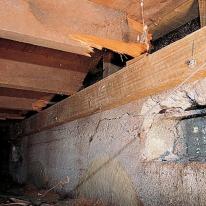Bearer and/or joist damage/deterioration
Listed under: timber and wood-based, timber, Subfloor, bracing, framing, durability, borer, rot
Cause
Timber sizes are too small for the span/loading
Repair
-
first, determine the actual subfloor framing required, including span dimensions and timber sizes. These can be calculated by an architect, designer or chartered professional engineer
-
options may include adding new bearers/joists or replacing bearers or joists
-
new subfloor framing timber should be treated to H1.2 and piles to H5
-
work that involves foundations (piles, bearers) falls into the category of ‘restricted building work’. If you are paying a tradesperson to do this, the work must be carried out or supervised by a licensed building practitioner with a Foundations licence
Cause
Untreated or inadequately treated timber
Repair
-
the only effective long-term solution is to replace the untreated/inadequately treated timber with new H1.2 timber of the appropriate sizes and spans (and H5 for timber in ground contact)
-
work that involves foundations (piles, bearers) falls into the category of ‘restricted building work’. If you are paying a tradesperson to do this, the work must be carried out or supervised by a licensed building practitioner with a Foundations licence
Cause
Rotted timber
Repair
-
you can check for rot in timber with a screwdriver. Try to push it into the timber and if the screwdriver easily enters the timber, then the timber is rotten
-
rotten bearers or joists should be replaced with new H1.2 timber. If just one part is affected, replace the affected area and at least 1m either side of the rot. In many cases it may be a better option to replace the whole member
-
work on foundations (which includes bearers) falls into the category of ‘restricted building work’. If you are paying a tradesperson to do this, the work must be carried out or supervised by a licensed building practitioner with a Foundations licence
Cause
Borer infestation in timber
Repair
-
borer damage to old timber is relatively common, especially with untreated or sap timber. Infestation by the common house borer (which leaves round holes) generally ends before framing timber becomes structurally unsound. Common borer attacks sap timber; most framing has sufficient heartwood to avoid serious weakening
-
infestation by two-tooth borer (which produces oval holes) is more serious as they can attack heartwood as well as sapwood
-
bearers or joists (or parts of them) that show signs of structural weakness should be replaced with new H1.2 timber
-
work on foundations (which includes bearers) falls into the category of ‘restricted building work’. If you are paying a tradesperson to do this, the work must be carried out or supervised by a licensed building practitioner with a Foundations licence
-
if you are thinking about fumigation to kill adult borer when they are on the wing (approximately November to March), consult a firm that is a member of the Pest Management Association of New Zealand
-
borer damage is more common in damp situations. Ensure the subfloor is dry
Cause
Excessive notching or drilling through the timber for pipes or wiring
Repair
-
the appropriate repair depends on the level of damage to the bearer or joist
-
where the bearer or joist still provides adequate support it may be possible to fix a proprietary metal support in place
-
it may also be possible to fix H1.2 timber plates to either side of the defective timber
-
in extreme cases the bearer or joist may need to be replaced
-
engage an architect, designer or chartered professional engineer to calculate and plan the repairs/replacements required
-
replacing damaged bearers falls into the category of ‘restricted building work’. If you are paying a tradesperson to do the repair/replacement work, they must be a licensed building practitioner with a foundations licence
Cause
Floors have been overloaded
Repair
-
see the first repair above. The two options are to either (a) remove the cause of overloading repair the damage, or (b) repair the damage and ensure the subfloor framing is sufficient for the loads it will face
-
work on foundations falls into the category of ‘restricted building work’. If you are paying a tradesperson to do this, the work must be carried out or supervised by a licensed building practitioner with a Foundations licence





